ISSN: 1204-5357
ISSN: 1204-5357
| Filipe Moreira Research Associate, Innovation and Development Centre, Higher Institute of Gaya, V. N. Gaia, Portugal Postal Address: Av. dos Descobrimentos 333, 4400-103, V. N. Gaia, Portugal Email: ispg3239@ispgaya.pt Mr. Filipe Moreira is a research associate in the Innovation and Development Centre at ISPGaya, V. N. Gaia, Portugal. His research interests are information management, telematic applications and ecommerce. |
| Pedro Rocha Research Associate, Innovation and Development Centre, Higher Institute of Gaya, V. N. Gaia, Portugal Postal Address: Av. dos Descobrimentos 333, 4400-103, V. N. Gaia, Portugal Email: ispg3088@ispgaya.pt Mr. Pedro Rocha is a research associate in the Innovation and Development Centre at ISPGaya, V. N. Gaia, Portugal. He is also working in a consulting company in the field of information systems. His research interests are information systems, networking architectures and information management. |
| Fernando Almeida Professor and Research Manager, Department of Informatics Engineering, Faculty of Engineering, University of Porto, Porto, Portugal Postal Address: Rua Dr. Roberto Frias s/n, 4200-465, Porto, Portugal Email: almd@fe.up.pt Prof. Fernando Almeida is a professor and research manager at Faculty of Engineering, University of Porto, Portugal. He received his PhD at Faculty of Engineering at Porto. He has published several peer-reviewed research papers in the field of information systems, ecommerce and electronic security. |
| © Filipe Moreira, Pedro Rocha and Fernando Almeida, 2012 |
Visit for more related articles at Journal of Internet Banking and Commerce
Internet Banking has emerged as one of the most remarkable and profitable ecommerce applications over the last decade. The home banking is a service that allows new ways of interaction with customers, turning possible to overcome the barriers of distance between bank institutions and their clients. Despite the increasing importance of home banking, very few studies were made in the Portuguese context and, therefore, very little are known about the profile of users of this service particularly in some specific domains. This paper has the objective to show the results of our study considering the use of Internet Banking among Portuguese college students contextualized with other existing studies/publications and performing a critical analysis from the obtained results. We realized that the large majority of students use Internet Banking, consider the service safe, adopt it essentially for money movements and have a strong perception that bank institutions adopts anti-frauds mechanisms. Additionally, our study demonstrated that there is a strong association between the simultaneously use of home banking and MBNet services, and we realized that the user perception about the safety of Internet Banking increases with the use of these services.
Keywords |
| Internet Banking; Portuguese college students; perceived security; MBNet; e-Commerce |
INTRODUCTION |
| The Internet has revolutionized the way people communicate around the world. This revolution allowed the use of online services, such as Online/Internet Banking. The use of Internet Banking turned possible to overcome the obstacles of distance and time to facilitate the balance verifications, money transfers, checks requests, bills payments, among other things (Kumbhar, 2011). However, on the other side, the growing use of Internet Banking service has made the attacks on its security more frequent and more strategic. As a way to overcome these problems, banking institutions are focused on the computer system’s security. In order to provide a better service to their customers, they are alerting them, providing a matrix card and advising frequent change of keyword (Singh and Beekhuyzen, 2006). |
| In Portugal, the first bank born in Internet was the Global Investment Bank, in 1999. Nowadays, the vast majority of the Portuguese banks offer the Home Banking service, such as BESNet appeared in 1998, BPINet in 2000 and Online Direct Box in 2003, because it allows a faster interaction with the clients and a higher flexibility, at a low cost (Guimarães, 2010). Behind the Automatic Teller Machines (ATMs) and personal contact with the bank, the home banking is currently the third most used interaction way adopted by Portuguese clients to contact with their main bank institution (Ferreira, 2011). According Marktest agency (Rocha, 2012) the use of home banking in Portugal almost tripled between 2003 and 2011. The percentage of residents in Portugal with more than 15 years old and bank account using the home banking rose from 11,8% in 2003 to 30,6% at the end of 2011, which means that 2.2 million of Portuguese citizens accessed their bank via the Internet (Rocha, 2012). |
| There are numerous scientific publications that depict the reality of markets such as Europe, United Kingdom, Brazil, Australia and New Zealand. Those studies indicate the income, the level of education, the age, the professional status and the geographical area as variables that explain the use, or not use, of Home Banking service (Aladwani, 2011; Akinci et al., 2004; Clemes et al., 2006). In Portugal, the studies of this subject were almost non-existent until recent years, considering that the only available and complete study about the profile of Internet Banking users was only conducted in 2011 (Guimarães, 2011). |
| The main goal of this article is to present our study about the use of Internet Banking by Portuguese students of higher education. For that, it will be analyzed how often this kind of population use this service, what kind of policies are been adopted by the banks, the performance of Internet Banking and how the students see the security of this service. It is expected that this article and the achieved results are a reference for future studies. |
STATE OF THE ART |
| Internet Banking services are growing among our society. A 2009 Service Quality Evaluation (Khan and Mahapatra, 2009) stated that the Internet Banking is going to be very crucial having increasing percentage of younger generation population with computer literacy. This is an interesting conclusion since we can understand that we might be studying a very specific population when we are talking about college students. So it is predictable that it might be a service that Portuguese college students are much familiarized. |
| Consumer behavior in the adoption of Internet Banking may parallel aspects of online consumer behavior in general. Li et al. (1999) found that knowledge of the Internet channel, convenience, experience, perceived accessibility and utility are key influences on online consumer behavior. Of these, convenience has increasingly been linked to online consumer choices. For example, a study conducted by Pew (2005) found that convenience was the main reason US consumers selected the Internet channel for new services. Consumer concerns about Internet security, privacy and trust have also been noted by many experts (e.g. Miyazaki and Fernandez, 2001; Gefen et al., 2003; Nissenbaum, 2004). Finally, transaction cost economics theory suggests people will choose the cheaper method to transact when choosing between electronic or traditional services (Huang, 2002). |
| Several studies about the Internet Banking adoption have been conducted in recent years. According to Durkin et al. (2008) and Kumbhar (2011) age of customer, security concerns, willing to adopt online banking are some factors that contribute to adoption of Internet Banking, plus, inadequate knowledge and support are very important barriers in using Internet Banking. Liechtenstein (2006) also confirms the study of Pew (2005) when indicates banking service convenience, as the dominant factor in banking method choices though these methods guide the customer to missed advantages and benefits available from Internet Banking – advantages which are likely to increase with time as banks add more services to their Internet offerings. |
| When we focus our attention studying college students, we must understand that they have very distinguished paths and knowledge. |
| For instance, customers perceive a greater uncertainty when a transaction is carried out using the Internet and are very concerned about security in the online context (Casaló et al., 2007). However, it is not expected that a computer science student perceive a greater insecurity degree than a human sciences student mostly because of his knowledge of how systems are built, what security measures are available, if he is being a victim of phishing, etc. Though security is essentially a perception component usefulness of Internet Banking outweigh security concerns, trust emerge as the single most important variable in the use of Internet Banking (Singh and Beekhuyzen, 2006). |
| According to Guimarães (2011) it was clear that the Portuguese user profile is a person between 25-45 years old, married, living at urban areas, with specialized jobs, having High School degree or higher and a monthly earning of 1000€. The regular Portuguese user adopts the Internet Banking mainly for balance checking and payments (Guimarães, 2011). Additionally, the Portuguese Communication Observatory, in a study conducted by OverCom (2007), confirms an average age between 25 to 44 years old being an individual with higher education degree, using mostly check balance services. Given this data it will be interesting to show how different the college Portuguese students behave considering the Internet Banking evolution, available services, security perception and their reasons to adopt or not the Internet Banking services and what services they use the most. |
METHODOLOGY |
| In this study we wanted to analyze what services of Internet Banking the Portuguese college students uses the most and verify some possible relations that would might exist between some variables. We are particularly interested to analyze how long the customer uses the Internet Banking services and what kind of services he uses, the gender and the use of Internet Banking, the use of Internet Banking services and the security perception, etc. |
| To gather this data we made a questionnaire using the Google Docs platform and delivered it through the mailing lists of major Portuguese college institutions: FEUP, ISEP, ISPGaya, Católica University, Minho University, Lisbon University, Aveiro University, Lusíada University, UTAD, ISMAI, IPVC. Selecting these institutions we wanted to mix colleges from the public and private sector and different courses as well. |
| The purpose of these questionnaires was to gather data like gender and age, realize if students use the Internet Banking services and analyze what is their perception of Internet Banking security. With this information in mind we also wanted to know the most used Internet Banking services, the perceived advantages of the service, verify if the customer uses the MBNet service – a Portuguese banking institutions service that allows the customer to create virtual credit cards for the Internet use only – and their security perception about this service, and finally the customer past experience considering security issues like phishing and his behavior in this matter. |
| The questionnaire is composed by twelve questions. These questions were organized in the following four groups: |
| 1) Personal information about each respondent (age, and sex); |
| 2) Information regarding the use of Internet Banking (if is it adopted, years of utilization, main advantages, and services used); |
| 3) Information about the use of MBNet (if is it adopted, and reasons for its adoption); |
| 4) Information concerning about the perceived Internet Banking security (opinion about the system security, received phishing by email, behavior of user about phishing, and anti-fraud policies adopted by bank institutions). |
| From our enquiry we obtained 257 answered questionnaires. With this study we aim to answer some questions / relate some data: |
| 1) Analyze the time of use of Internet Banking services and the respondents average age; |
| 2) Evaluate the adhesion to MBNet by citizens who assume to use Internet Banking services; |
| 3) Relate the non-use of Internet Banking services with the low security perception and the phishing reception; |
| 4) Relate the time using home banking and perceived security; |
| 5) Relate the adoption of anti-fraud mechanisms by bank institutions and perceived security by their customers; |
| 6) Evaluate the awareness degree of the respondents when asked if they provide their credentials. |
RESULTS |
| From 257 answered questionnaires only 35 were women’s (27 stated that used Internet Banking) and, representing only 13.6%, we will not differentiate results based on the sex. |
| A. Age Vs Internet Banking use |
| From the 212 persons (82.5%) that assumed the use of Internet Banking: |
| • 54, representing 25%, stated that they use Internet Banking for less than 2 years and the average age of this group is 20.6 years old; |
| • 88 persons said that they use these services since 2 to 5 years ago, this represents 41.5% and their average age is 23.9 years old; |
| • 57 respondents answered that they use Internet Banking services since 5 to 10 years ago and their average age is 30 years old representing 26.9% of the 212 persons that stated that use Internet Banking services; |
| • Only 13 respondents answered that they use Internet Banking for more than 10 years. Representing only 6.1% the average age of this group is 35.5 years old. |
| Although it is observed that the age of the individuals follows the longest use of Internet Banking services it is also possible to observe that, probably due the academic context with a higher number of students rather than teachers, the total average age is 25 years old. |
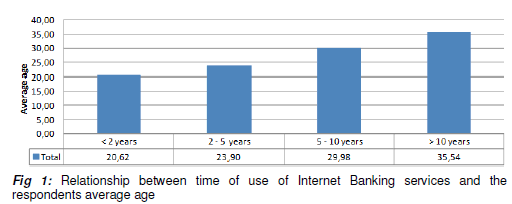 |
| As we can see through the Figure 1, the years of use of Internet Banking services increases with respondents’ age. It is important to mention that 45 of our 257 respondents assumed that did not use any Internet Banking service which represents 17.5%. |
| B. Perceived security |
| Considering that 45 persons stated that did not use any Internet Banking services (Profile 1) it is interesting to observe that 4.4% state it as very safe and 24.4% as safe. On the other hand 15.6% state it as unsafe. 55.7% of our respondents did not answer. |
| Comparing this data to the ones who use Internet Banking services (Profile 2) we obtained, from 212 respondents, 14.2% consider it very safe and 80.9% safe. Compared to those who do not use Internet Banking, 3.8% of them consider the service “unsafe”. 1.9% did not answer. This situation is illustrated in Figure 2. |
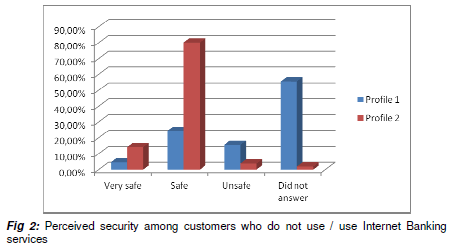 |
| An interesting point is to verify that among customers who stated that used Internet Banking services manly to do money movements – excluding balance check operations and customers who did not answer – which represents 91% of our respondents, 15.8% considered it very safe and 80.5% safe. On the opposite side 3.7% stated it as unsafe. |
| This results leads to higher values of perceived security. In fact, taking into consideration this data we can conclude that when a customer understand this service as very safe or safe he/she tends to use money transfer related services as it does not represent a risk. |
| Trying to analyzing the reasons that lead our respondents to do not use Internet Banking services we wanted to understand what kind of influence the reception of phishing e-mail and the adoption of bank institution anti-fraud measures had in their behavior. |
| Persons who state that do not use any Internet Banking service (Profile 1), when questioned if ever received an e-mail asking for Internet Banking credentials, 26.7% answered positively, 28.9% negatively and 44.4% did not answer. Comparing to the ones who use Internet Banking services (Profile 2), 25.5% answered positively, 74.1% negatively and only 0.5% did not answer. |
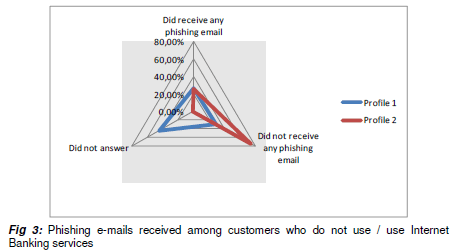 |
| For the question “Do you consider that you Bank Institution adopt anti-fraud measures?” 17.8% of our respondents answered positively, 13.3% negatively and 68.9% did not answer (Profile 1). Comparing to the ones who use Internet Banking services (Profile 2), 92.5% answered positively, 5.2% negatively and only 2.4% did not answer. This situation is illustrated in Figure 4. |
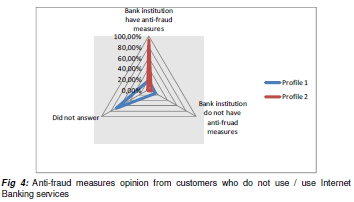 |
| Even comparing two distinct samples (the ones who use Internet bank services and the ones who does not), the differences are very clear and we can assume that the reception of Phishing and the awareness of policies assumed by their bank institution may lead to use or not use Internet Banking services. |
| Customers who use Internet Banking consider that their bank institution has anti-fraud measures and also received less phishing e-mails compared to the respondents who do not use any Internet Banking service. |
| An interesting point is to observe that 100% of our respondents who received phishing emails stated that they did not answer with their credentials. In this context, a college, it would be expected a high awareness degree but stills quite impressive that all the respondents did not provide any sensitive data to this e-mails. |
| About the perceived security we conclude that even, from a global sight, our respondents finds Internet Banking services safe factors like phishing reception and the bank institutions policies leads them to avoid or use this services. |
| C. MBNet |
| Taking in consideration that it is possible to use MBNet through ATM terminals, the respondents who do not use Internet Banking services (Profile 1) 22.2% also use MBNet, 48.9% do not use this service and 28.9% did not answer. Comparing to the ones who use Internet Banking services (Profile 2) 67.5% use MBNet, 28.8% do not use and 3.8% did not answer. This situation is illustrated in Figure 5. |
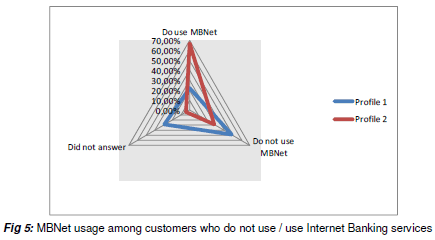 |
| From a global point of view, from our respondents, 59.5% use MBNet service, 32.3% do not use and 8.2% did not answer. |
| This study was also important to determine whether or not there is an association between the following elements: |
| • Use of home banking services and MBNet; |
| • Time using home banking and perceived security; |
| • Adoption of anti-fraud mechanisms and perceived security. |
| The traditional approach to characterize and measure such associations is the adoption of a correlation analysis, which measures and interprets the strength of a linear or nonlinear (e.g., exponential, polynomial and logistic) relationship between two continuous variables. Most common correlations measures are Pearson and Spearman coefficients. However, when we deal with categorical data, we must use a different approach. The main technique for analyzing categorical data is the Chi-square test for independence. |
 |
| In Table 1 we determined the chi-squares and p-values for each scenario. The DF corresponds to the degrees of freedom. Looking to Table 1 we can conclude that there is an association between the considered elements for the scenarios 1 and 2. We cannot conclude that there is an association between anti-fraud mechanisms and perceived security (Scenario 3). For example, in the Scenario 3, p-value > 0.05 level of significance). |
| The chi-square value tells us only that there is a relationship somewhere in the data, but does not give information about the nature of association. In order to get an idea about if the association is strong or weak we use a residual analysis. |
| In the context of a two-way table (two dimensions), a residual analysis is defined as the difference in the observed frequency and the expected frequency: residual = fo - fe. To more easily make comparisons, the use of standardized or adjusted residuals are preferred. Standardized residuals are calculated by dividing the residual value by the standard error of the residual. |
 |
| The adjusted residuals associated with use of home banking services and MBNet (Scenario 1) is presented in Table 2. |
 |
| The results of Table 2 indicate that there is a strong association between the two questions. Most users say that use simultaneously home banking and MBNet services. |
| The adjusted residuals associated with time using home banking services and perceived security (Scenario 2) is presented in Table 3. |
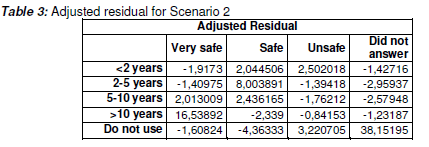 |
| It was found that users that adopted home banking services for a long time (>10 years) consider very safe these services. On the other hand, typically users that only recently adopted home banking services (<2 years) feel more insecure about the security protection of home banking. |
DISCUSSION |
| Age is one of the factors that contribute for how long the respondents have been using Internet services with our results showing that the older the respondent is the long time they have been using Internet Banking. |
| We also wanted to understand the reasons that lead to avoid these services comparing the respondents who use it and those who do not use it associating it their security perception, phishing e-mail reception and their perception of banking institutions policies related with Internet Banking. Though a high number – 55.7% - of respondents who stated that did not use Internet Banking did not respond we concluded that, compared to those who use it, they tend to have a worst security perception with 28.8% stating this services as Very Safe or Safe and 15.5% stating as unsafe or not safe at all. Even with lower percentage – 1.9% - of blank answers, respondents who use Internet Banking services 94.3% state it a very safe or safe and only 3.8% considered it as unsafe. From the high level of blank answers from respondents who do not use Internet Banking we can conclude about their ignorance in this issue. |
| Once again, when asked if ever received a Phishing e-mail, the respondents who do not use Internet Banking had a high value of blank answers – 44.4% - as the security perception; we concluded that these respondents are not familiar with Internet Banking not recognizing some concepts. Comparing respondents who use Internet Banking and those who do not, it is interesting to note that though the percentage of those who admit to have received some sort of phishing e-mail are similar in both cases, those who use Internet Banking stated to have not receive any phishing e-mail in a higher percentage number taking into consideration that only 0.5% did not answer to this question. |
| A very similar behavior is taken from the results to the question “Do you think that your bank institution have anti-fraud measures”? Once again, the respondents who do not use Internet Banking show an even higher degree of ignorance with 68.9% of users having not answer to this question. These results lead us to understand that not only factors like the perceived security, reception of phishing e-mail and bank institution policies contribute to the Internet Banking adherence but also the “Internet Banking literacy” and the convenient knowledge of its concepts contributes to the use of this service. |
| A service like MBNet, making possible to do payments without having a regular credit card helps the use of services like online betting. 1.6% of the general population in the United States has engaged in pathological gambling with an additional 3.85% having experienced gambling related problems. College students appear to be at a greater risk, with 5% reporting pathological gambling and over 9% reporting gambling related problems (Gayla, 2012). Taking the growth of services like e-commerce or online betting in mind and referring to our context it is interesting to observe that 59.5% of our respondents use MBNet. A higher value is achieved when surveying the ones who assume to use Internet Banking services, 67.5%. |
| Trying to understand if the physical credit card avoidance would be the very best factor between MBNet customers and, among a variety reasons like convenience, reliability and security, 51.6% of MBNet customers stated that the fact of not have to use a physical credit card is a factor that leads them to use this service. |
CONCLUSION |
| Internet Banking helps the communication between customers and bank institutions providing some crucial services like balance checks, service payments, stocks exchange and money transfers. Surveying Portuguese college institutions we were studying individuals who are, generally, very proficient and well informed about information technologies. |
| Taking into consideration our study context it would be predictable a low average age from our respondents. 25 years old as an average age would match recent studies (Guimarães, 2011) but, instead of tracing a profile, we wanted to conclude about factors that lead our respondents to use or to avoid Internet Banking services. In Portugal services like BESNet created in 1998, BPINet created in 2000 and Caixa Directa Online created 2003 are the first ever Internet Banking services created. With this dates in mind we wanted to trace the time of usage with the respondent age. |
| We concluded a high level of adherence of Internet Banking services, related with high levels of perceived security, which are dependent on factors like phishing reception and the awareness of bank policies for Internet Banking issues. Those who do not use Internet Banking showed us a generic ignorance about these factors though they consider these services generally safe. However, it was not possible to conclude the adoption of anti-fraud mechanisms by bank institutions will lead to an increased security perception among users. |
| Our study also showed us that MBNet service is much massified even between those who do not use Internet Banking services. The main reason for this use being the physical credit card avoidance follows the growth of e-commerce, on-line betting and other related services. |
| As global note it is interesting to perceive that our respondents who do not use Internet Banking services avoided answering to questions like perceived security, MBNet and anti-fraud measures. Though this respondents are in a very low number, at a high degree education level, stills surprising the not adherence to these services and the global indifference about it. |
References |
|
Copyright © 2025 Research and Reviews, All Rights Reserved